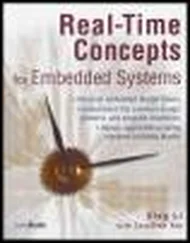Numerous hidden traps to this approach often catch the unwary newcomer to embedded development. When a given program is compiled, the compiler often knows how to find include files, and where to find libraries that might be required for the compilation to succeed. To illustrate these concepts, let's look again at the "Hello World" program. The example reproduced in Listing 2-4 above was compiled with the following command line:
gcc -Wall -o hello hello.c
From Listing 2-4, we see an include the file stdio.h. This file does not reside in the same directory as the hello.c file specified on the gcc command line. So how does the compiler find them? Also, the printf() function is not defined in the file hello.c. Therefore, when hello.c is compiled, it will contain an unresolved reference for this symbol. How does the linker resolve this reference at link time?
Compilers have built-in defaults for locating include files. When the reference to the include file is encountered, the compiler searches its default list of locations to locate the file. A similar process exists for the linker to resolve the reference to the external symbol printf(). The linker knows by default to search the C library (libc-*) for unresolved references. Again, this default behavior is built into the toolchain.
Now consider that you are building an application targeting a PowerPC embedded system. Obviously, you will need a cross-compiler to generate binary executables compatible with the PowerPC processor architecture. If you issue a similar compilation command using your cross-compiler to compile the hello.c example above, it is possible that your binary executable could end up being accidentally linked with an x86 version of the C library on your development system, attempting to resolve the reference to printf(). Of course, the results of running this bogus hybrid executable, containing a mix of PowerPC and x86 binary instructions [14] In fact, it wouldn't even compile or link, much less run.
are predictable: crash!
The solution to this predicament is to instruct the cross-compiler to look in nonstandard locations to pick up the header files and target specific libraries. We cover this topic in much more detail in Chapter 12, "Embedded Development Environment." The intent of this example was to illustrate the differences between a native development environment, and a development environment targeted at cross-compilation for embedded systems. This is but one of the complexities of a cross-development environment. The same issue and solutions apply to cross-debugging, as you will see starting in Chapter 14, "Kernel Debugging Techniques." A proper cross-development environment is crucial to your success and involves much more than just compilers, as we shall soon see in Chapter 12, "Embedded Development Environment."
2.4. Embedded Linux Distributions
What exactly is a distribution anyway? After the Linux kernel boots, it expects to find and mount a root file system. When a suitable root file system has been mounted, startup scripts launch a number of programs and utilities that the system requires. These programs often invoke other programs to do specific tasks, such as spawn a login shell, initialize network interfaces, and launch a user's applications. Each of these programs has specific requirements of the system. Most Linux application programs depend on one or more system libraries. Other programs require configuration and log files, and so on. In summary, even a small embedded Linux system needs many dozens of files populated in an appropriate directory structure on a root file system .
Full-blown desktop systems have many thousands of files on the root file system. These files come from packages that are usually grouped by functionality. The packages are typically installed and managed using a package manager. Red Hat's Package Manager (rpm) is a popular example and is widely used for installing, removing, and updating packages on a Linux system. If your Linux workstation is based on Red Hat, including the Fedora Core series, typing rpm -qa at a command prompt lists all the packages installed on your system.
A package can consist of many files; indeed, some packages contain hundreds of files. A complete Linux distribution can contain hundreds or even thousands of packages. These are some examples of packages that you might find on an embedded Linux distribution, and their purpose:
• initscripts Contains basic system startup and shutdown scripts.
• apache Implements the popular Apache web server.
• telnet-server Contains files necessary to implement telnet server functionality, which allows you to establish Telnet sessions to your embedded target.
• glibc Standard C library
• busybox Compact versions of dozens of popular command line utilities commonly found on UNIX/Linux systems. [15] This package is important enough to warrant its own chapter. Chapter 11, "BusyBox," covers BusyBox in detail.
This is the purpose of a Linux distribution as the term has come to be used. A typical Linux distribution comes with several CD-ROMs full of useful programs, libraries, tools, utilities, and documentation. Installation of a distribution typically leaves the user with a fully functional system based on a reasonable set of default configuration options, which can be tailored to suit a particular set of requirements. You may be familiar with one of the popular desktop Linux distributions, such as RedHat or Suse.
A Linux distribution for embedded targets differs in several significant ways. First, the executable target binaries from an embedded distribution will not run on your PC, but are targeted to the architecture and processor of your embedded system. (Of course, if your embedded Linux distribution targets the x86 architecture, this statement does not apply.) A desktop Linux distribution tends to have many GUI tools aimed at the typical desktop user, such as fancy graphical clocks, calculators, personal time-management tools, email clients and more. An embedded Linux distribution typically omits these components in favor of specialized tools aimed at developers, such as memory analysis tools, remote debug facilities, and many more.
Another significant difference between desktop and embedded Linux distributions is that an embedded distribution typically contains cross-tools, as opposed to native tools. For example, the gcc toolchain that ships with an embedded Linux distribution runs on your x86 desktop PC, but produces binary code that runs on your target system. Many of the other tools in the toolchain are similarly configured: They run on the development host (usually an x86 PC) but operate on foreign architectures such as ARM or PowerPC.
2.4.1. Commercial Linux Distributions
There are several vendors of commercial embedded Linux distributions. The leading embedded Linux vendors have been shipping embedded Linux distributions for some years. Linuxdevices.com , a popular embedded Linux news and information portal, has compiled a comprehensive list of commercially available embedded Linux distributions. It is somewhat dated but is still a very useful starting point. You can find their compilation at www.linuxdevices.com/articles/AT9952405558.html.
2.4.2. Do-It-Yourself Linux Distributions
You can choose to assemble all the components you need for your embedded project on your own. You will have to decide whether the risks are worth the effort. If you find yourself involved with embedded Linux purely for the pleasure of it, such as for a hobby or college project, this approach might be a good one. However, plan to spend a significant amount of time assembling all the tools and utilities your project needs, and making sure they all interoperate together.
Читать дальше












